In a much more relaxed and calm game for the Netherlands, they dominated Qatar who showed little or nothing in a World Cup that leaves them with a totally poor record, and even the worst in terms of nations that have hosted the tournament in their country. With 1 goal in favour, 7 against and 0 points, Félix Sánchez’s team was anti-competitive and they could not contain their rivals who, in the games against the Asian team, were clearly superior with great comfort.
It was the same case for Louis Van Gaal’s team which came in a rather strange way at the start of the World Cup. What they had shown in the first game, being a dynamic, rotational team that played based on the ball, almost completely disappeared and became an extremely flat team that did not generate chances and offered harmless possession that Senegal could contain. for a large part of the party, and later Ecuador.
The Netherlands found, with certain vital entries such as Memphis Depay or Marten de Roon, a more fluid team that carried out its build-up processes well, with a lot of mobility between the lines and exchanges of positions between forward players, with more behind and vice versa. Also, Timber’s tenure as the third centre-back continues to prove once again that he is the right one for that role.
With little more to add, the Netherlands finished their match 2-0 against Qatar and will have to face the USA in the next phase. In this tactical analysis, we dive into the tactics of both teams in form of analysis and see how Louis Van Gaal’s Netherlands won against Qatar and qualified for the knockout stages.
Lineups
Louis Van Gaal did not give up on his 3-4-2-1 formation, once again using Andries Noppert as the goalkeeper, with a defence featuring Virgil Van Dijk, Jurrien Timber, Nathan Aké, and the typical wing-backs, Denzel Dumfries on the right and Daley Blind left. The midfield underwent a change with the positive entry of Marten de Roon, which allowed Frenkie de Jong to be much more mobile. The attack consisted of Davy Klaasen as #10, Cody Gakpo and Memphis Depay as constantly moving forwards.
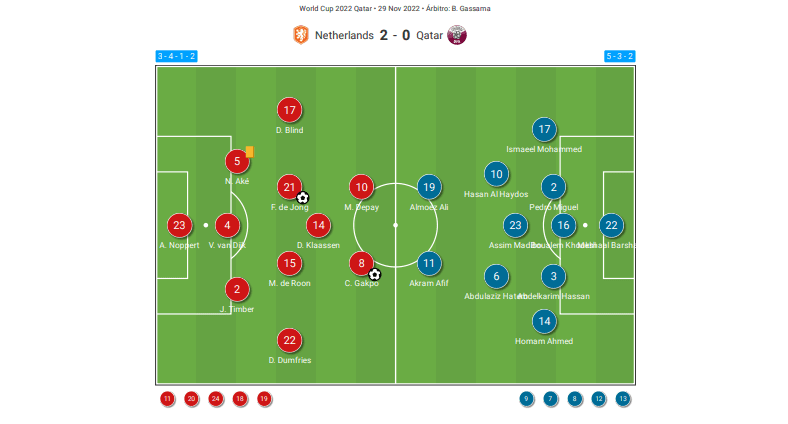
Félix Sánchez took to the field again with his 5-3-2 formation, with Meshaal Barsham in goal, Homad Ahmed as left-wing-back, Abdelkarim Hassan, Boualem Khoukhi, Pedro Miguel as centre-backs in the back-three and Ismael Mohammad as right -wing-back. The midfield had Assim Madibo, Abdulaziz Hatem and Hassan Al Haydos; The lead again had Almoez Ali and Akram Afif.
Frenkie de Jong’s mobile role with Marten de Roon
The Netherlands seeks and achieved in the UEFA Nations League to be superior to their rivals from the mobility between the lines and movements inside or outside of several of their pieces within the starting eleven. The rotations in midfield and attack are the ones that make the Netherlands progress the fastest and best, constantly looking to exchange channels and heights through the thirds of the pitch.
Frenkie de Jong, being an extremely vital player for Louis Van Gaal in different roles, was given one where he played the most solid, against Qatar, in which he could show more of his technique, ball progression and his excellent ball retention, as well as a fairly agile mind to decide the pass and keep advancing with supporting runs for his teammates.
With the arrival of Marten de Roon, the Barcelona midfielder was able to play more freely and further up the field, like a box-to-box, which went up and down frequently, exchanging heights with Davy Klaassen or Marten de Roon, a trio that created havoc on the Qatari block. His role as a connector between the defence or the #6 with the three attacking players was a complete success in this match.
Infinite movements and rotations arose in the match, if we tried to catalogue and show each one of them we would make an article that would never end. However, we are going to put the magnifying glass on the most interesting and important in the construction and elaboration of plays of the Oranje.
Early in the game, we began to see Davy Klaasen’s support and drop moves, which led to dangerous receptions between the lines for the Qatari team. Frenkie de Jong understood and read his movements well, and he helped his team with a one-two, in which he always sought to be the forward released man. Normally Frenkie was found stepping on the half-space at the edge of the box. If he received at this kind of height shown below, he would carry it through the spaces, a massive facet of his game.
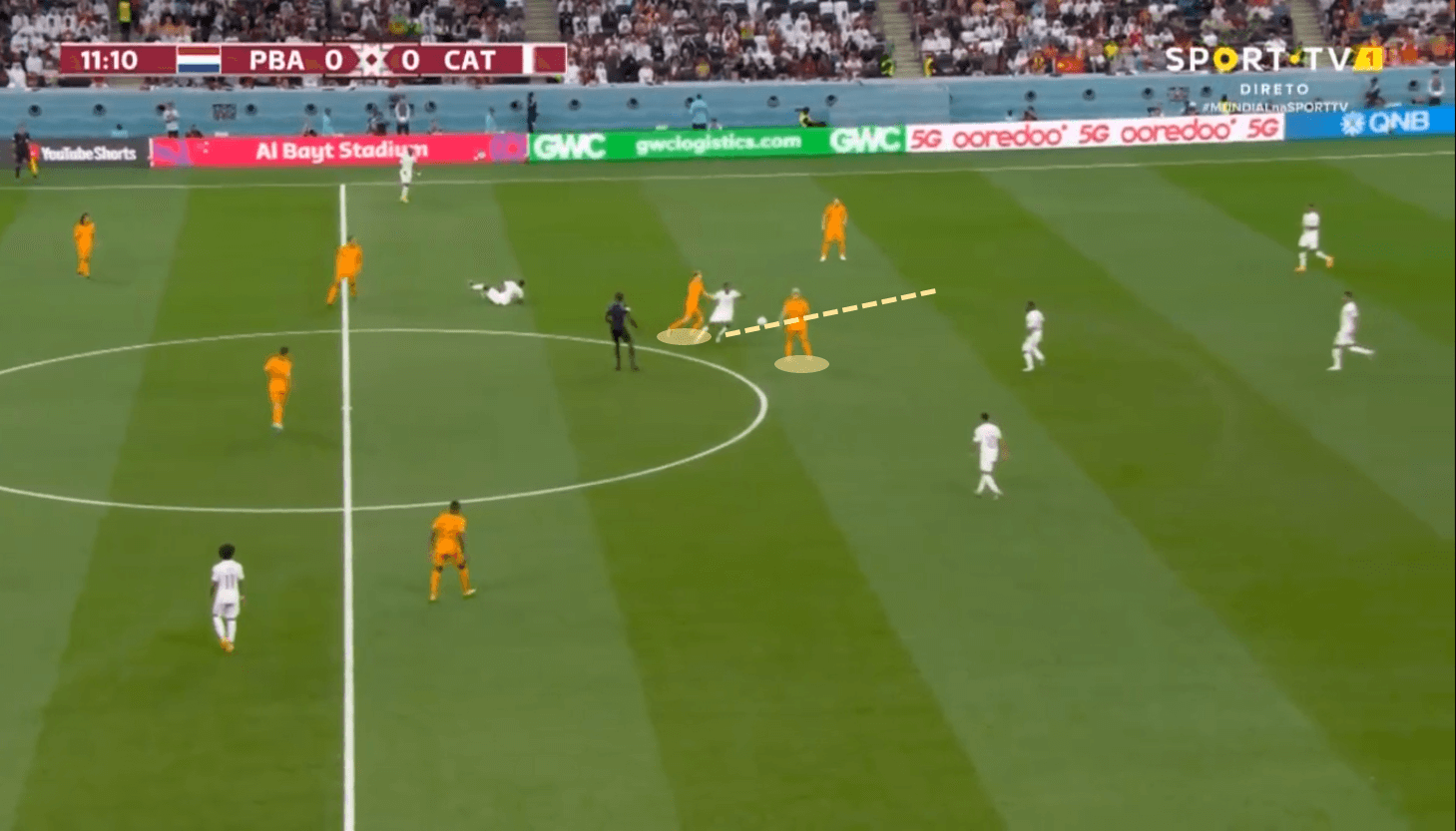
The Dutch build-up used to start with Marten de Roon shorter than Frenkie, but these two started to move frequently and Qatar did not decide who to go to mark or which player had to mark him.
One of the interesting things is that when Van Gaal’s men had the ball, one of them who was raising his position in the field would position himself very close to the other, on the same side, thus seeking to combine quickly and turn in a circle to continue progressing. Many times this was seen in the early stages of playmaking.
For example, the Netherlands was looking for this positioning to bring in from one side, with closer players, in order to play two or three times there and drop players like Klaasen or even more advanced players like Gakpo and Memphis Depay in the middle. These types of plays were common, they also had the drops of a player with excellent distribution like Klaasen.
In this sequence, we can see that De Roon moves to the half-spaces and looks to receive from Frenkie, who then un-marks to the sides and progresses the ball to the other wing. The play begins like this, and ends on the other side of the pitch with three in midfield, along with Klaasen in the same line as De Roon and De Jong higher.
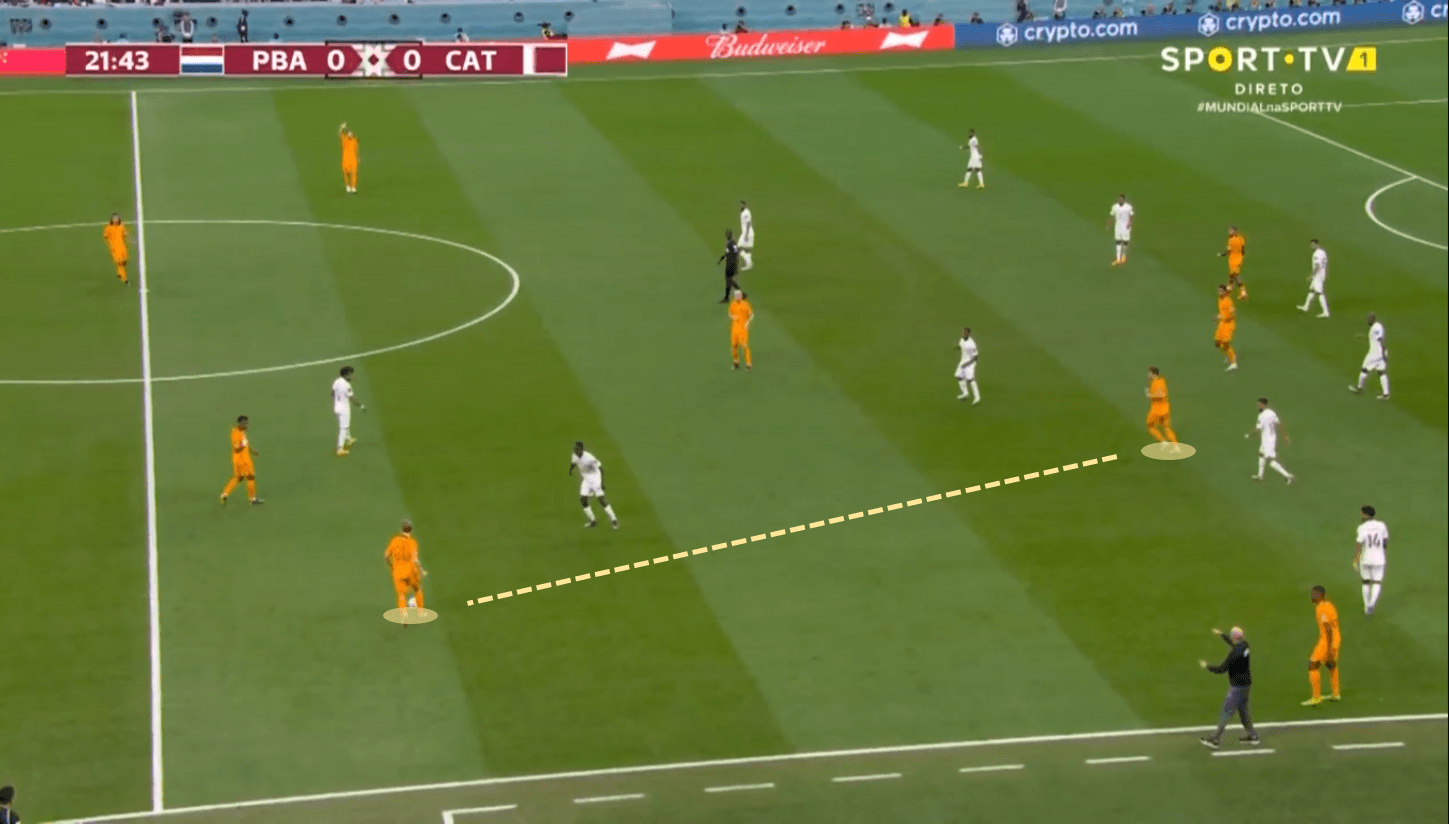
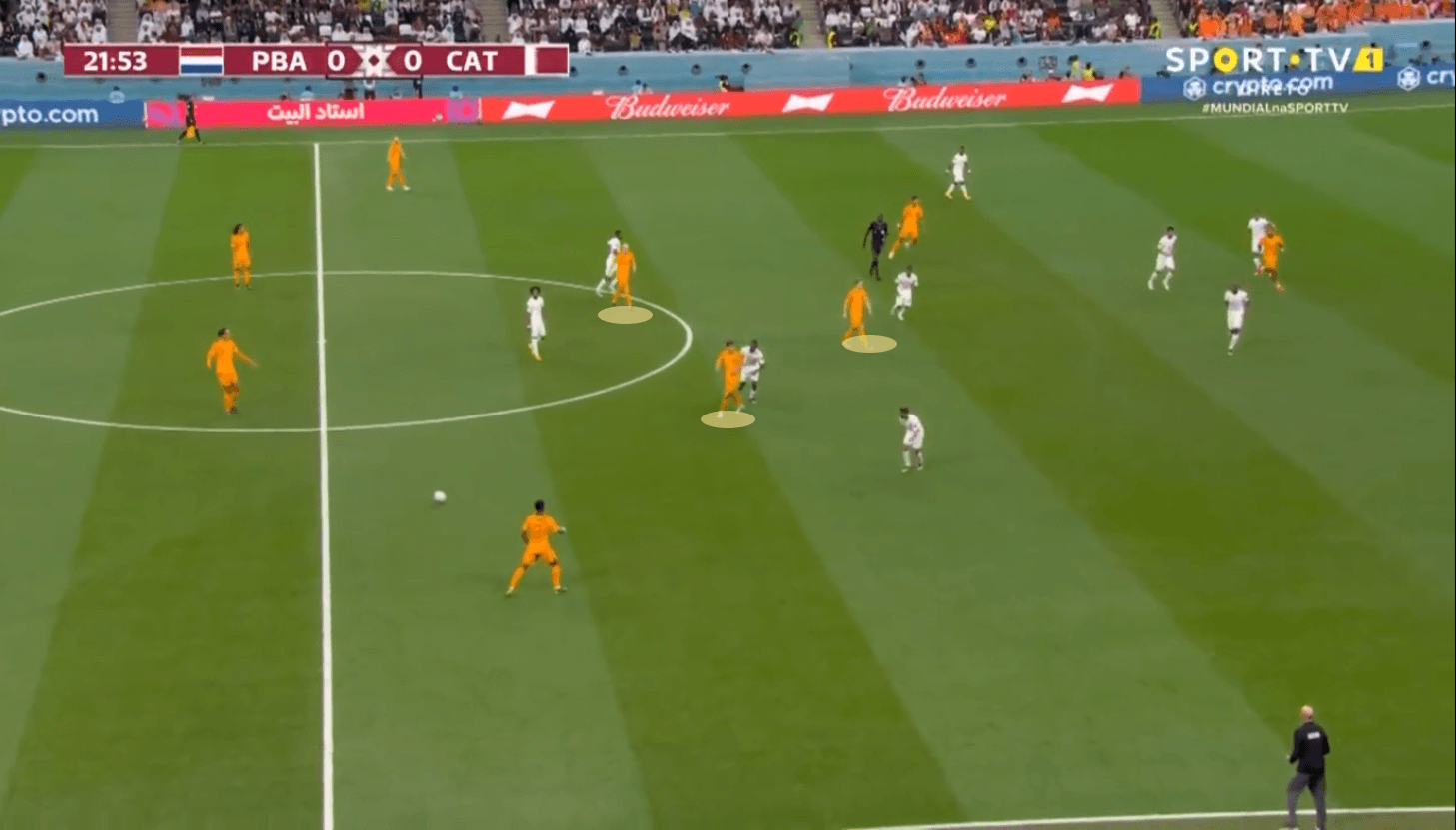
One of Frenkie de Jong’s duties in higher positions was to look to be the clearest passing line in the vision of Nathan Aké, an excellent ball-progressor player from the left for the Netherlands. He has shown at Manchester City his ability to find players between the lines with ease makes him extremely exquisite in his technique and this is frequently sought in the Oranje context as well.
Frenkie’s back movements, added to first-time passes to his sides were the key to making this go well and it did. Aké was normally given a lot of space to carry the ball, another great facet in him and he found de Jong more clearly on the road.
In the image, you can also see perfectly what was the idea and the partner sought. If Aké found that angle and pass option, he was confident to execute it. When the ball reached de Jong, it travelled rapidly from his foot towards De Roon, who, with a stretched and slow Qatari defence, was wide open in the middle.
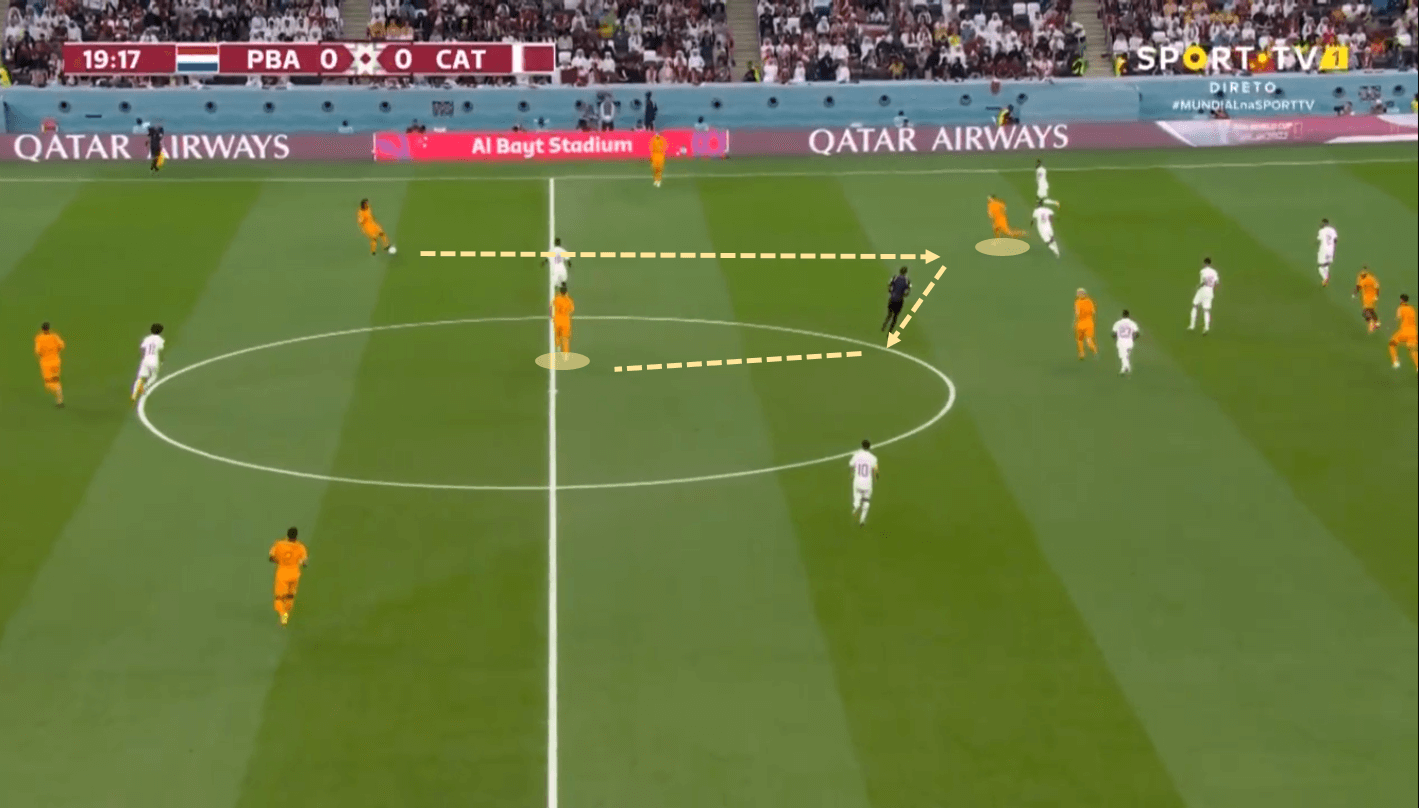
The movements of the team of Louis Van Gaal, the former Manchester United coach, continued to be seen very fluidly on the pitch. De Roon continued to trade channels and pitches with de Jong and Klaasen, while Jurrien Timber grew more comfortable playing inverted in central zones, something he is one of the smartest players in the world to do.
So the tactical adjustments continued to be seen during the course of the game: De Roon tried to go wide open, pinning one of the Qatari wing-backs well on the wide channels, stretching the last defensive line, which could be attacked between the spaces for the players more on the outside like Blind or Dumfries, but also inside at the edge of the box by Gakpo, Depay or Klaasen.
When De Roon went wide, Timber took his place as a midfielder. The Netherlands sought to clear this midfielder towards the outside lane, above all, to clear the congested central lanes at certain times by the hosts, where Timber later appeared to receive inside.
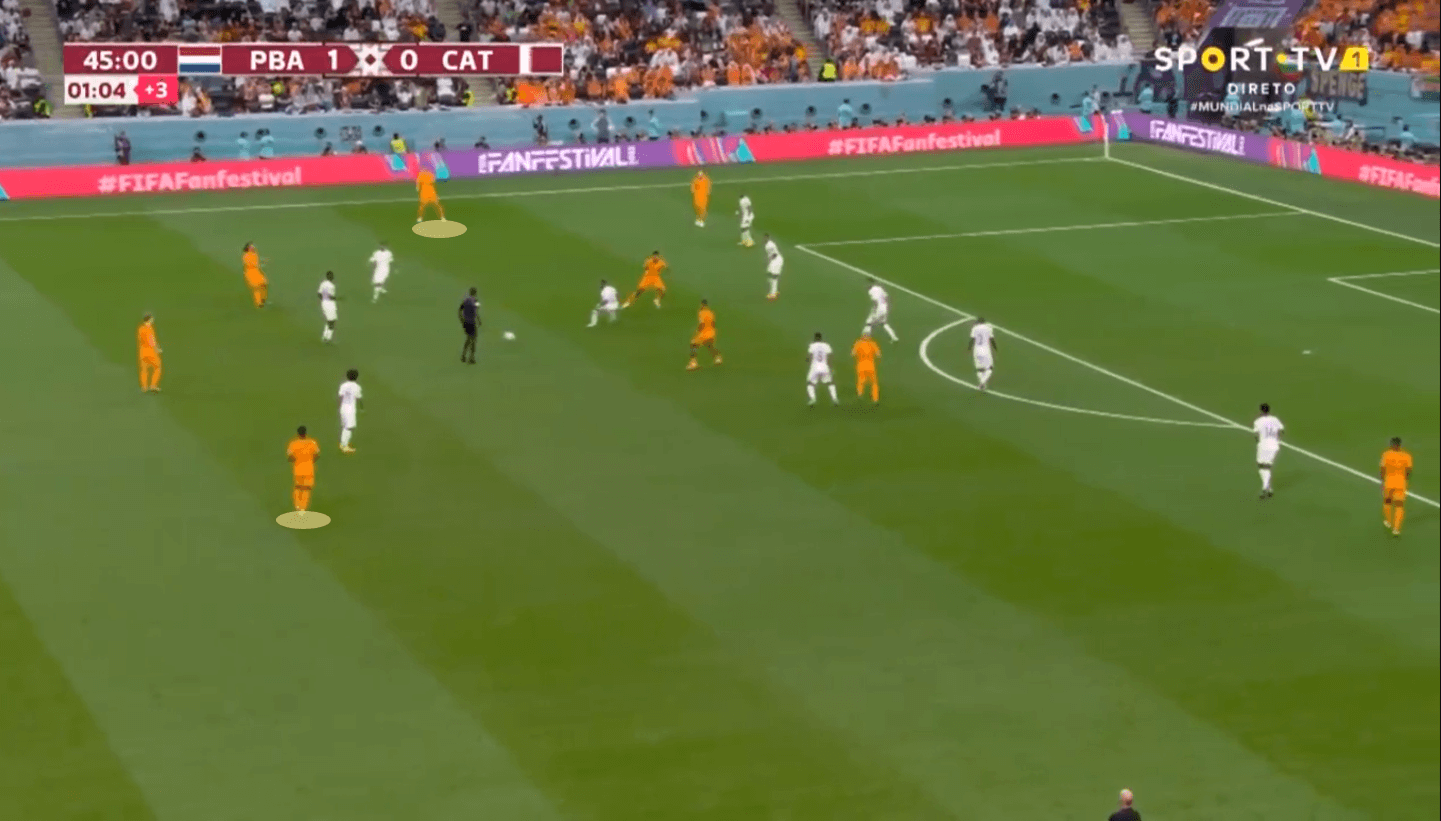
The Netherlands showed a great level of mental, communicative and tactical connection to use rotations that can leave the team in a very bad position on the field, but if they are well executed and understood, they will generate a lot of damage, as they did to Qatar.
Attacking rotations between Klaasen-Gakpo-Depay
Van Gaal’s team was very dangerous because in addition to what was happening in the middle, there were as well too many movements in attack, which left the Qataris without thinking and without a fast reaction time. What the Netherlands was looking for were connections between the attacking three in order to break the line with quick combinations between them.
They sought to play extremely narrow, in order to receive the ball, running between the lines looking to be supported after passing in very small pockets that Qatar could not contain. Usually, the three players were pretty close, one breaking into space after passing while two others hit one-two link-ups to activate the third man, or himself just doing the job of dragging the mark to open channels for them.
As we can see below, Klaasen, Gakpo and Depay played in attacking positions too close, which attracted many players in the middle, who with the technical superiority of the Dutch in addition to their resolution in reduced spaces, found the necessary liquidity between the lines.
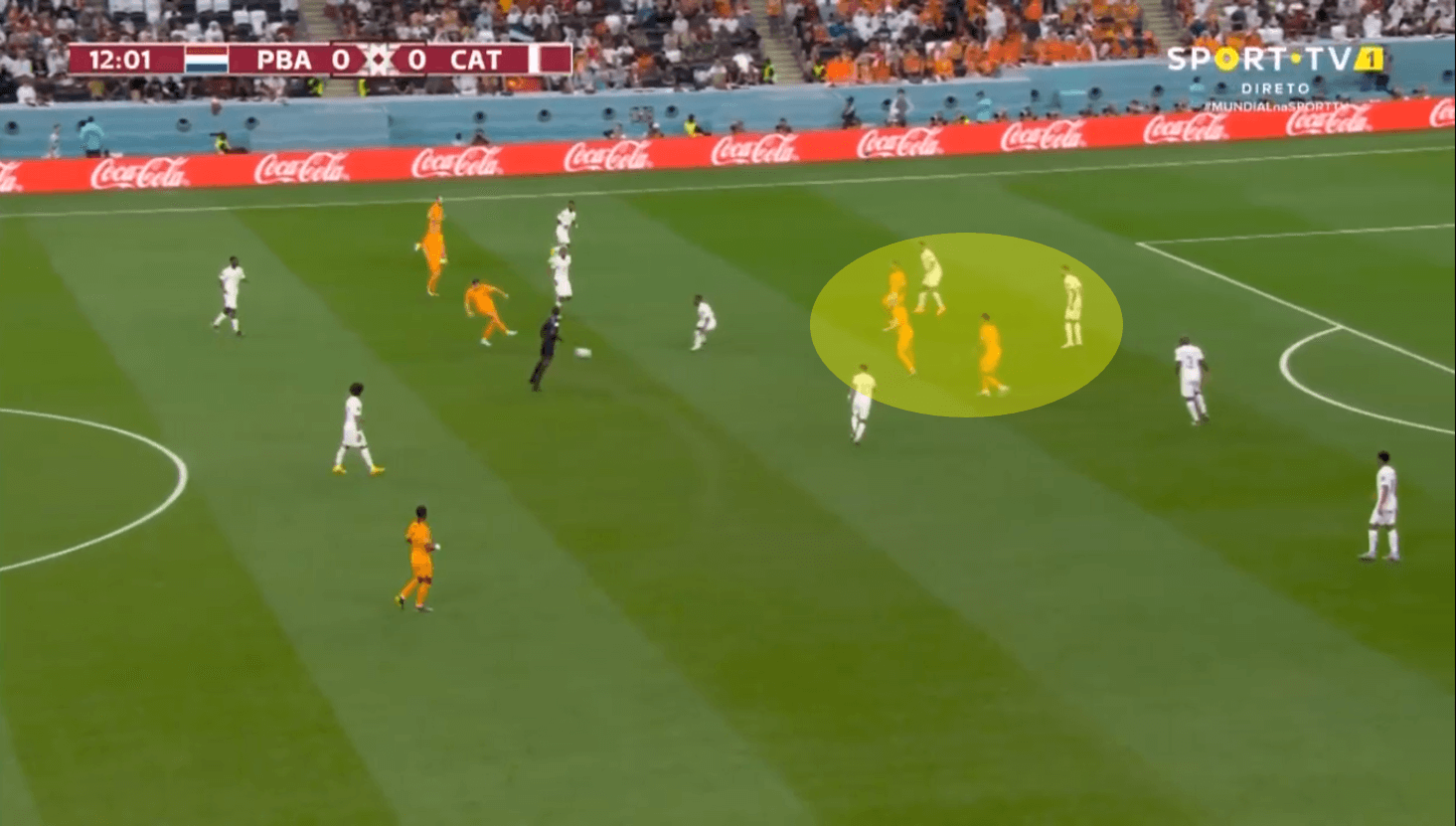
But initially, the attacking plays up front were generated thanks to the tactical and game understanding of a player like Davy Klaasen, the Ajax captain. With his maturity and vision on the pitch, he has explored different positions and contexts that have made him a top-class player.
His drops from these high areas so close to Gakpo and Depay drag several markers that he contained very easily with his back, who also has a physique that he knows how to use well to shield the ball. The passes between the lines of de Roon, the centre-backs or de Jong himself were key in Klaasen’s approaches to the base of the play, which accelerated all processes. He appeared through the lines so easily.
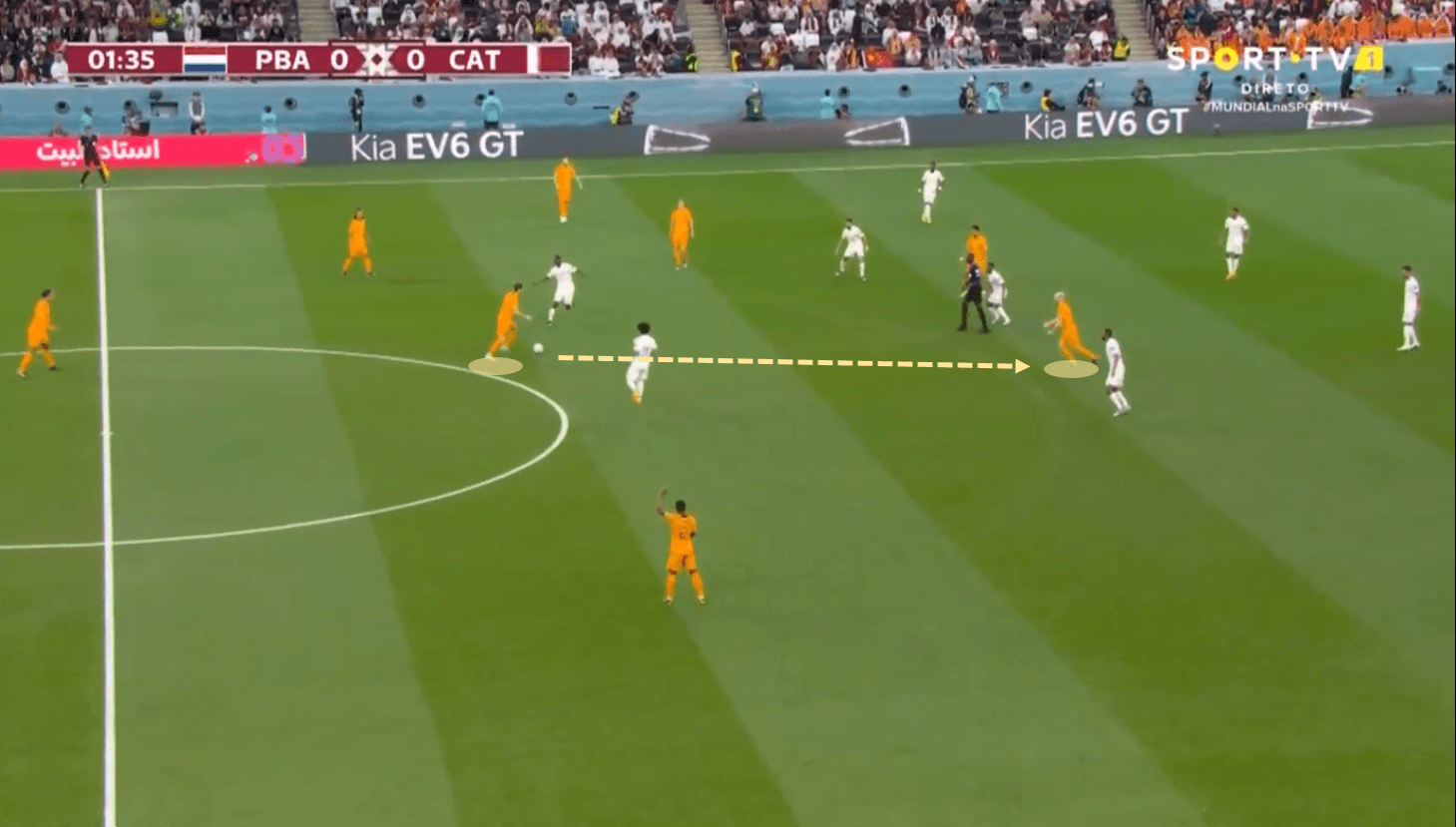
Even Davy was approaching the early stages of the build-up of the Netherlands’ game. He was the one who appeared as the third man and managed to appear inside, with very well-trained inside passes from the wing-backs of Van Gaal’s team, so that he could turn quickly and find players like Gakpo, Depay or de Jong taking its place up-front. This sequence is a very basic tactical display by the Oranje: They move the ball from one side to another, stretching the opponent, to then play the ball outside and find the player inside.
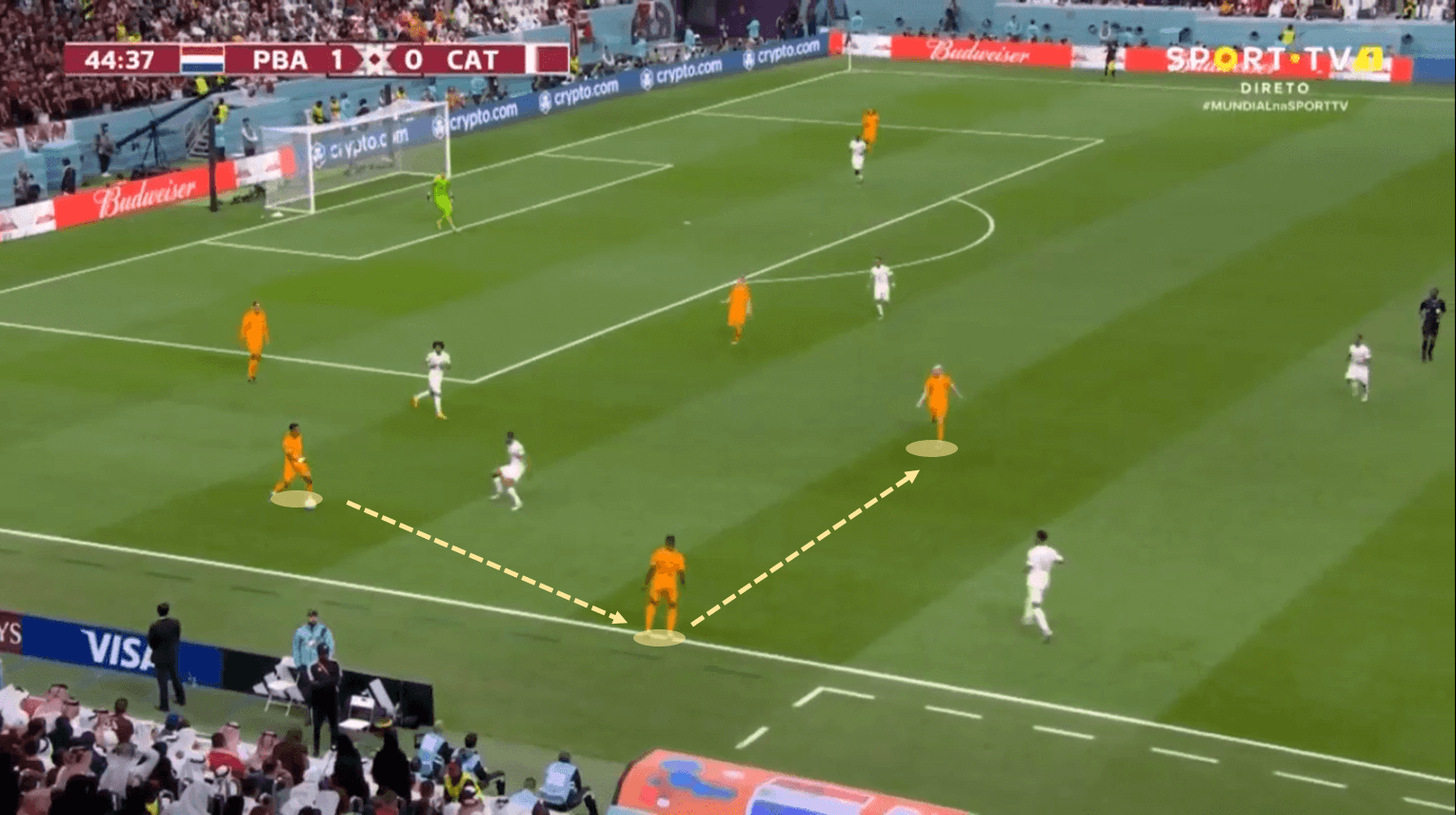
Going down so much really worked for the Dutch context, Klaasen’s input in this part of the game was vital, and he probably stood out as the best in the game, where he was always a passing line in front of de Jong, a connection that can provide a lot to Van Gaal’s team, especially if it is between the lines.
This move was one that was repeated constantly in the Netherlands: de Jong played for Klaasen, the latter for the wing-back which was pinning on the outside, Dumfries, who then returned Frenkie who found himself with space to turn and then launched passes to Gakpo or Depay who also moved from your area to receive lower.
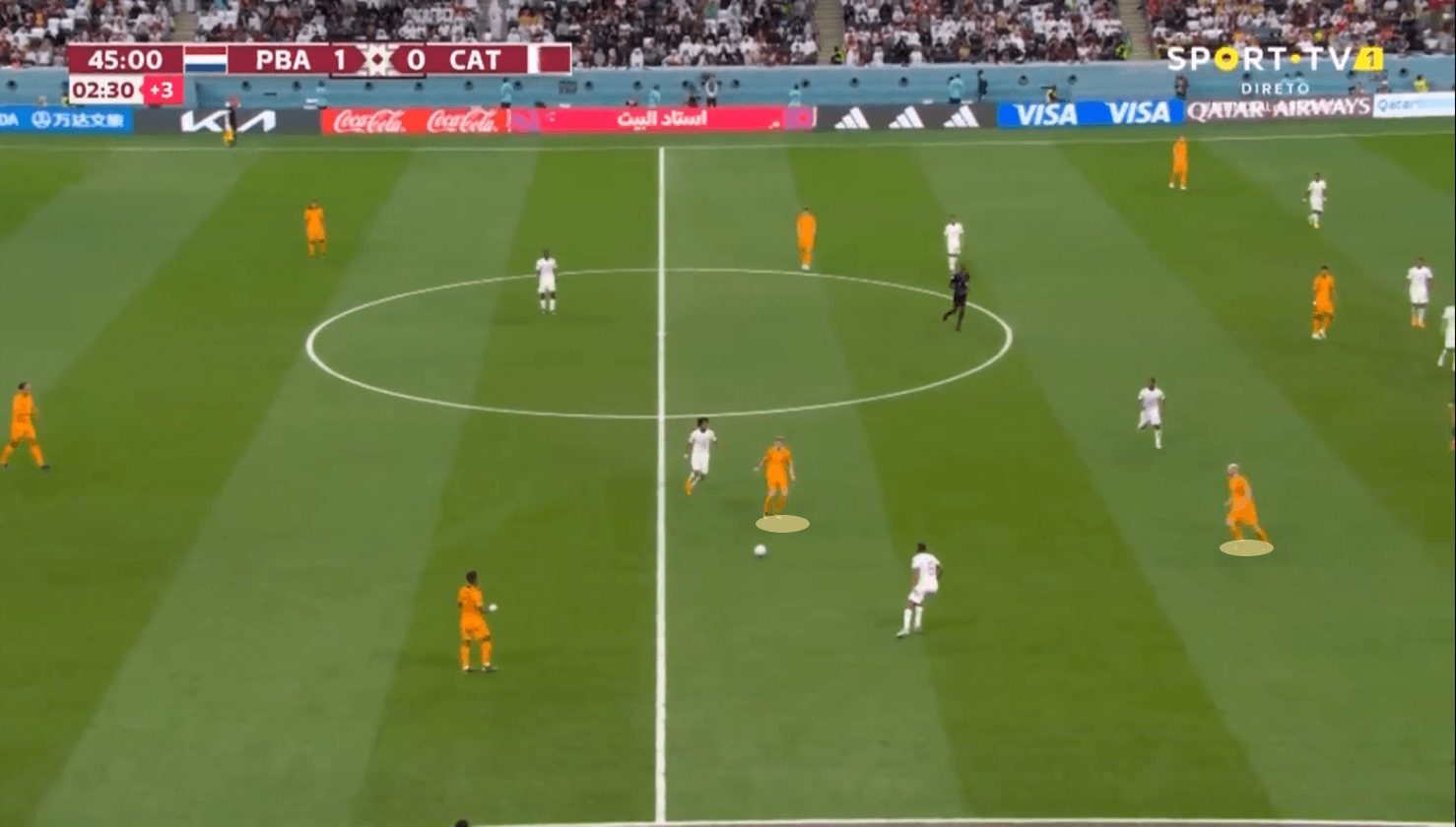
When the ball reached the last third, this triangle between the three forwards moved depending on the ball, usually with Depay as the first pass releaser, Gakpo or Klaasen, dividing roles between the receiver, second man or last receiver in one-two combinations.
The play before the goal was fascinating and was a clear example of what they were looking for with this offensive positioning. Depay released the first pass to Gakpo, then ran into space and dragged the mark, also looking to be the third man. Gakpo received and played first-time with Klaasen, who returned it to Cody with unbearable speed for Qatar, ending in an incredible goal from the PSV player.
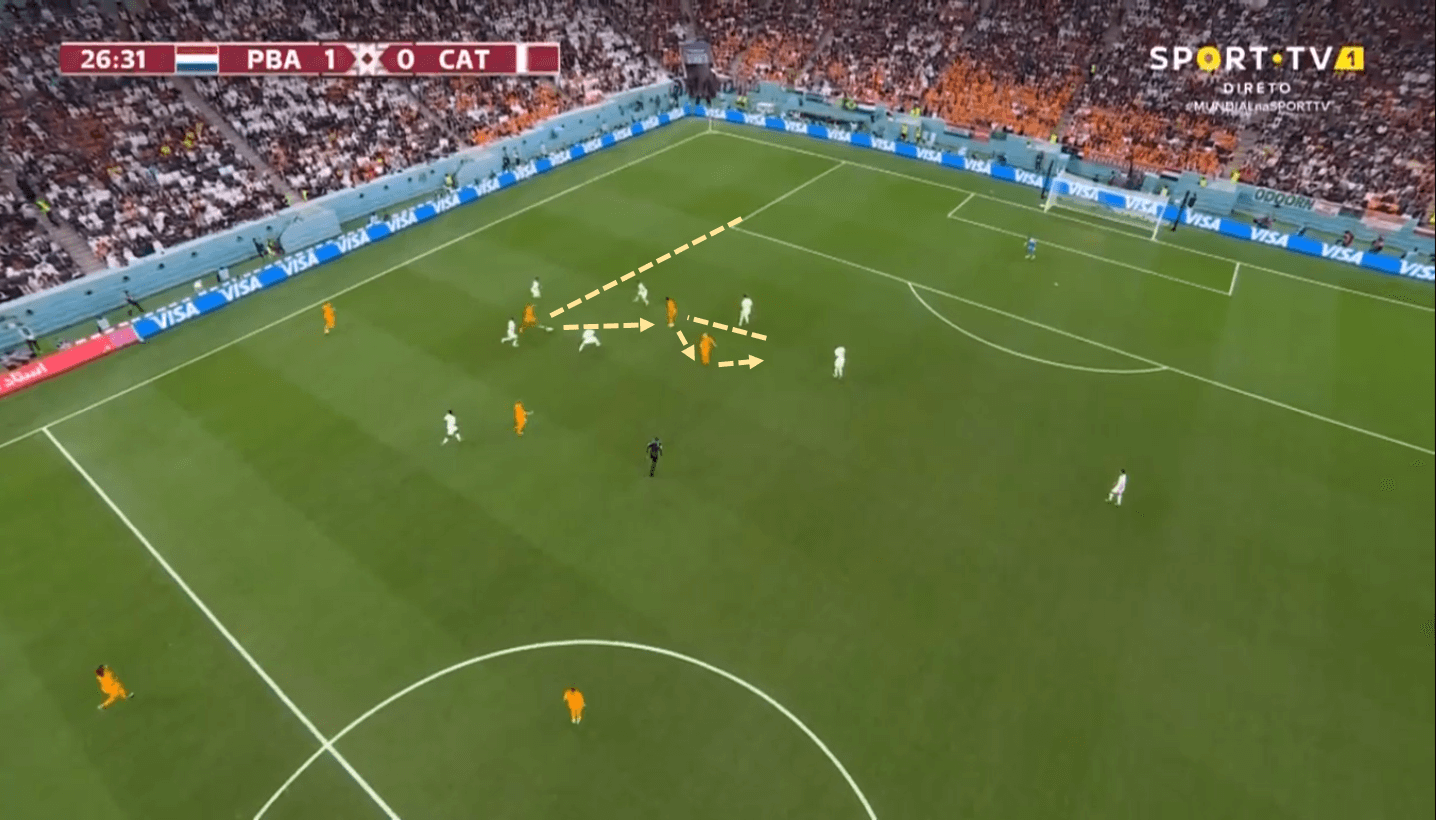
The second goal showed that the Netherlands does not have a single plan for the matches. Faced with Qatar’s low block, Davy Klaasen looked to support his wing-backs more, who received on the outside without much support. He decided to be key again in this, looking to be that previous pass to the cross.
Davy’s appearance as a mobile #10 in the Oranje team is not only positive due to his connection through central channels, but also his downward mobility to distribute the ball, or this support on the wings, where he made an excellent cross for the goal by Frenkie de Jong.
Even inside the rival box rotations occurred. Depay was left as the man to receive at the far post, Gakpo freed the area for Blind who sought to be the recipient of the cut-back, but also de Jong attacked the near post, which he was able to score after a rebound from the goalkeeper.
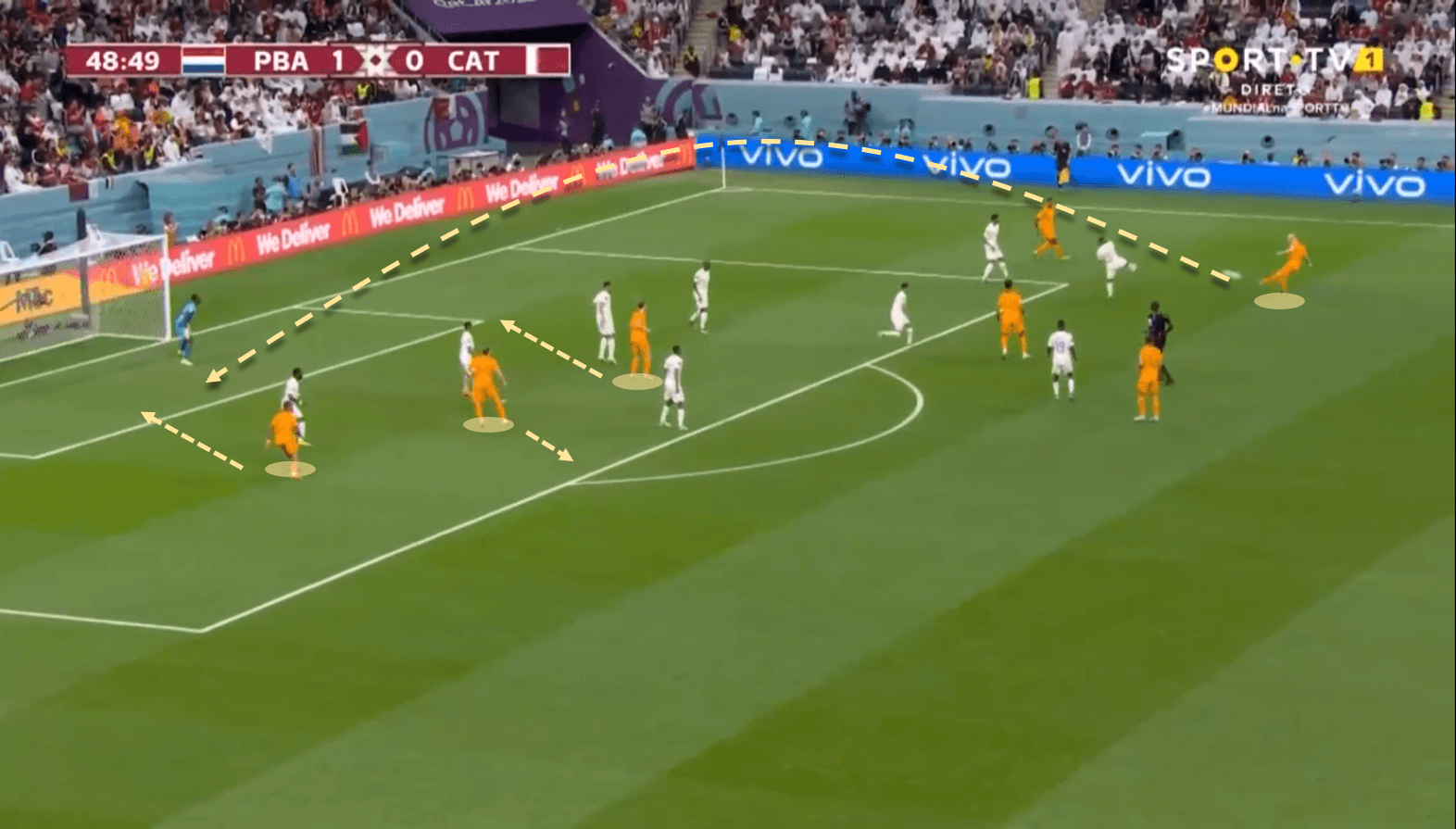
The entry of a player like Memphis Depay did extremely well for Van Gaal’s team, which seems to be in better physical shape for the following matches. His mobility and his quick combinations in small spaces were key, in addition to his movements to perform through-passes from the outside to the inside and then look for the cross inside the box, since he has a great scoring instinct.
Conclusion
Despite the rival, emotionally it is a victory that will be very useful for the Netherlands who will face the United States in the knockout stage, seeking to continue progressing in the most prestigious tournament in the world of soccer. Players like De Roon or Klaasen, as well as Depay, will surely start to be regulars given the fluidity that they finally brought to the team.

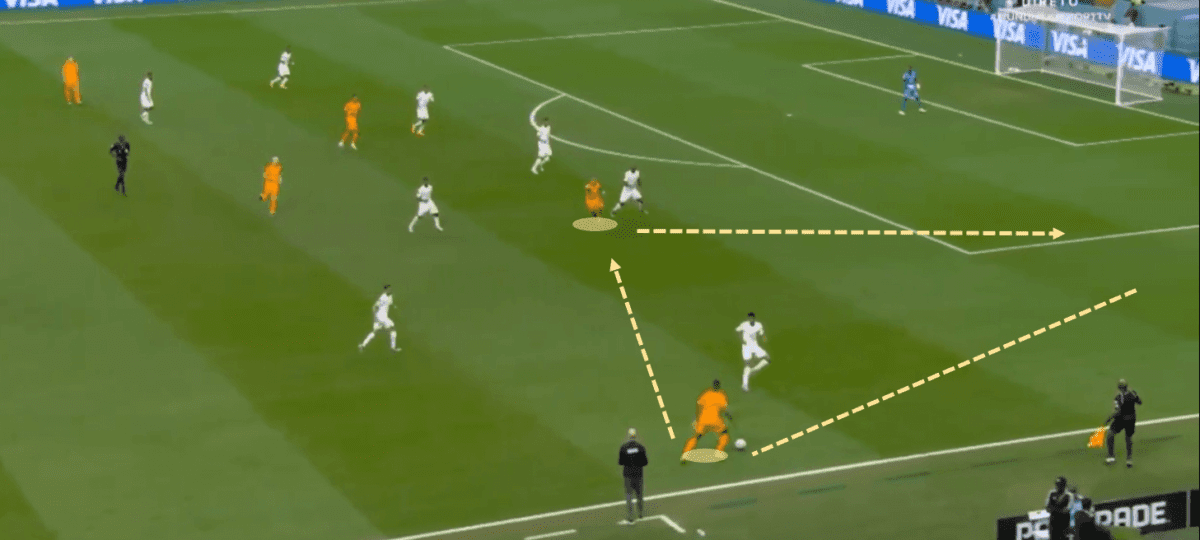




Comments